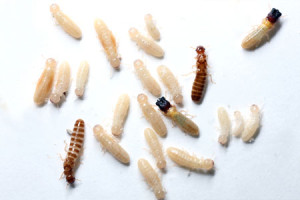Do We Have Drywood Termites in New Hampshire and Massachusetts?
By Chris Williams on July 14, 2014.
I have an old antique bureau that seems to be infested by something feeding on the wood. I’ve found lots of small round holes in the wood and sawdust. The pest control technician that was here said we had drywood termites and our house would have to be fumigated. Can that be true? I’ve tried to find something about drywood termites on the Internet but they don’t seem to be in this area. Do we have drywood termites here?—S. B., Methuen, MA
We’ve Definitely Got Termites, But Not Drywoods

Termites of the genus Cryptotermes, or drywood termites. These termites are not found in the Northeast.
There are many things wrong with this scenario. First, drywood termites do not occur in the Northeast. We do have subterranean termites but they have very different habits and would not likely be infesting a piece of furniture. I say that drywood termites do not occur here normally, but on rare occasions, they are accidentally transported here in furniture or other wood products.
Drywood termites (Cryptotermes spp.) are found in coastal areas of the southern U.S. from Florida north to Virginia, in the desert Southwest, along the Pacific coast to northern California, and in Hawaii. Unlike subterranean termites that have to live in the moist ground, drywood termites have a low moisture requirement and need no ground contact. They can live in a piece of wood without returning to a ground colony.
Termite Don’t Leave Round Holes in Wood
Even if your bureau was recently shipped from an area that had drywood termites, the evidence you describe does not fit with a drywood termite infestation. Termites don’t leave round exit holes in wood. What you describe sounds more like a powderpost beetle infestation. Both drywood termites and powderpost beetles have powdery frass but the “sawdust” is very different on close examination.
Finally, even if your bureau does have drywood termites, which is highly unlikely, there is no reason why your home would have to be fumigated to control the infestation. Drywood termite infestations tend to be localized to a single door, window frame, or piece of furniture. The infestation could be eliminated by simply removing and treating the bureau.
You definitely need a second opinion before you do anything. Contact another exterminator, or two. See “How to Choose a Pest Control Company.” Meanwhile, save any insects and sawdust that you find associated with the bureau. Drywood termites and powderpost beetles can be identified by their fecal pellets.
Photo by Davidmoradelpozo ([1]) [CC-BY-SA-3.0], via Wikimedia Commons